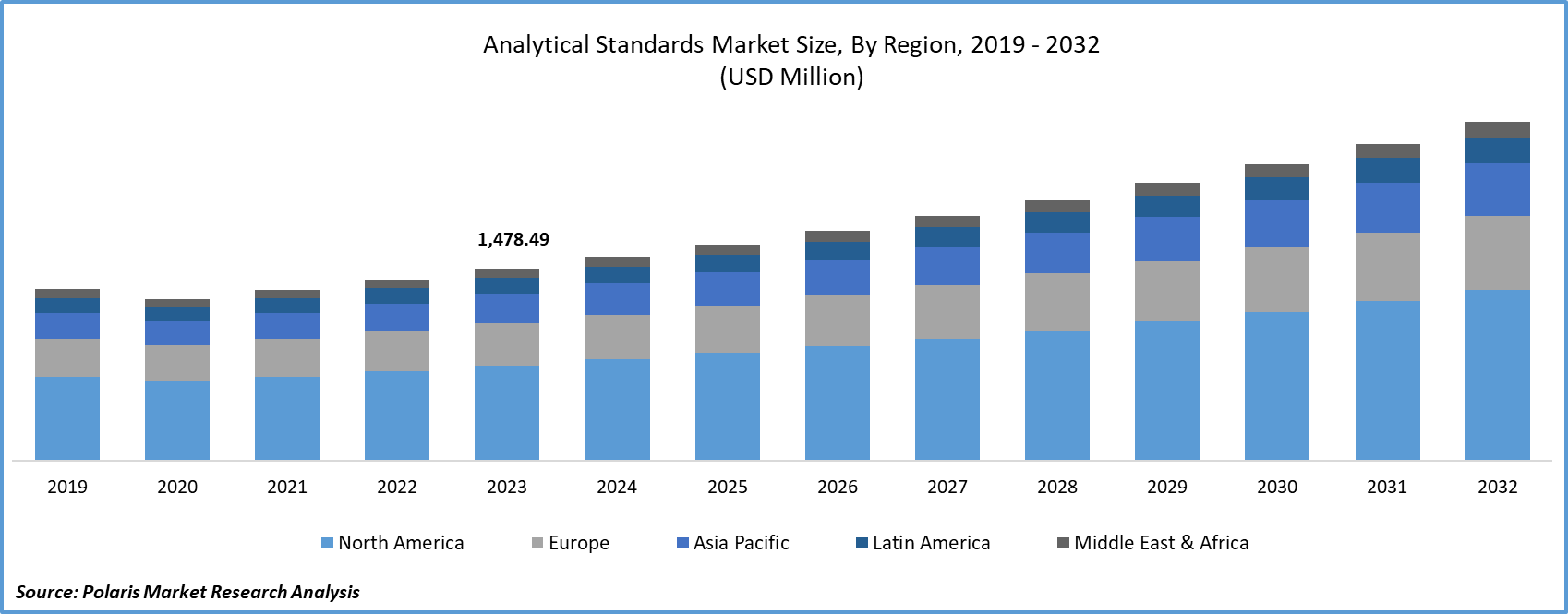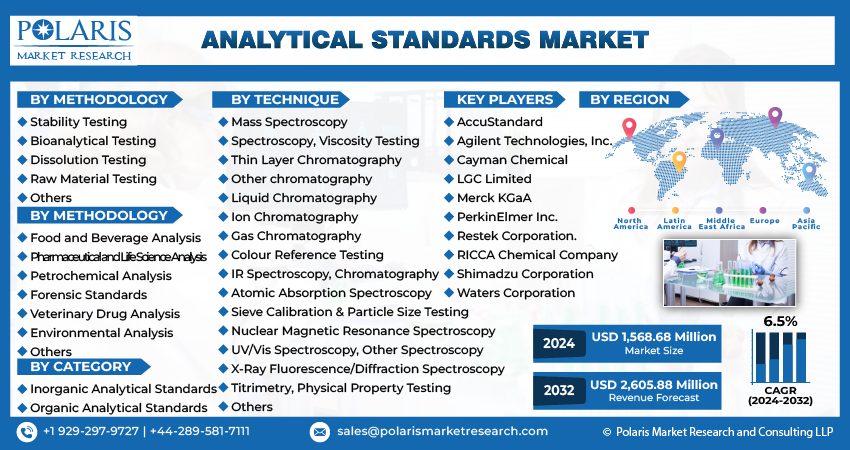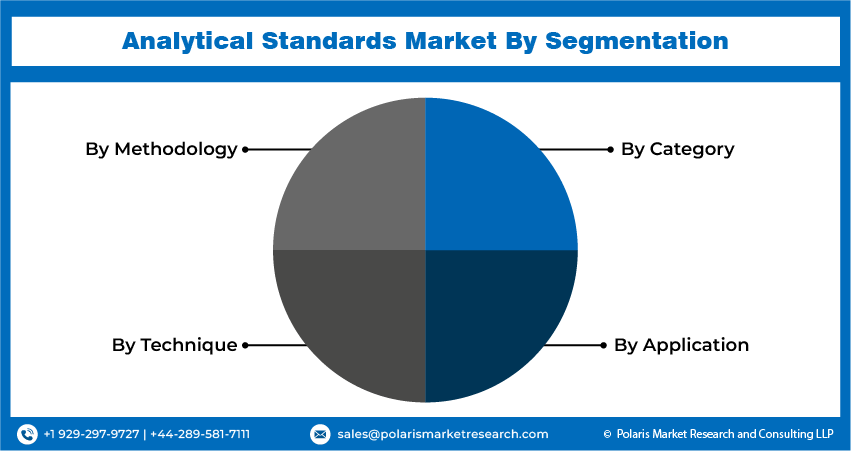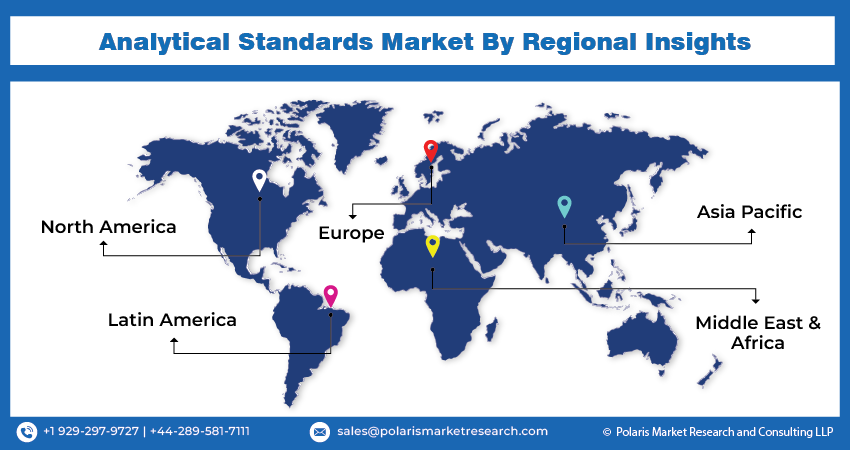
Analytical Standards Market Share, Size, Trends, Industry Analysis Report, By Category (Inorganic Analytical Standards, Organic Analytical Standards); By Methodology; By Technique; By Application; By Region; Segment Forecast, 2024- 2032
- Published Date:Mar-2024
- Pages: 118
- Format: PDF
- Report ID: PM4764
- Base Year: 2023
- Historical Data: 2019 – 2022
Report Outlook
Global analytical standards market size was valued at USD 1,478.49 million in 2023. The market is anticipated to grow from USD 1,568.68 million in 2024 to USD 2,605.88 million by 2032, exhibiting a CAGR of 6.5% during the forecast period
Analytical Standards Market Overview
An analytical standard refers to a substance characterized by high purity and a recognized concentration employed as a calibration reference for a particular test or assay. These standardized compounds serve to confirm the existence of specific elements in mixtures, enhance the accuracy of quantitative assessments, and facilitate testing or calibration of an analyzer. Fundamental techniques for analytical standards encompass Spectroscopy, physical property testing, chromatography, and titration. Various methods for analytical standards application encompass testing, conducting dissolution tests, assessing stability, performing bioanalytical testing, and testing raw materials.

To Understand More About this Research: Request a Free Sample Report
The expansion of the analytical standards market can be attributed to the rising need for testing in food and beverage industries, pharmaceuticals, and environmental monitoring. Stringent regulations, technological advancements, and the requirement for precise and dependable analysis across diverse industries further drive growth. Furthermore, the increasing demand for analytical standards in the pharmaceutical sector is a crucial factor propelling analytical standards market revenue growth. As drug molecules become more complex and there is a growing focus on safety and quality, pharmaceutical companies are increasingly turning to analytical standards for adherence to regulatory standards, drug development, and quality control. This pattern is anticipated to contribute substantially to analytical standards market expansion, driven by continuous investments in new drug development and testing by pharmaceutical companies.
Moreover, the increasing emphasis on food safety and quality by manufacturers is anticipated to sustain the demand for analytical standards in the upcoming years. Food manufacturers face the challenge of ensuring the safety and genuineness of their products, leading to a rising need for analytical standards in food testing and analysis. This development is poised to boost analytical standards market growth, especially in emerging markets where stringent food safety regulations are being implemented. Additionally, the analytical standards market is being propelled by the growth in environmental testing, driven by global attention to environmental protection and sustainability. Analytical standards play a crucial role in environmental testing, facilitating the monitoring of pollutants, assessment of environmental risks, and compliance with environmental regulations. As environmental testing becomes more widespread and advanced, this trend is expected to drive substantial analytical standards market growth.

Analytical Standards Market Dynamics
Market Drivers
Rigorous Quality Control Standards Across Diverse Sectors Bolster the Growth of the Analytical Standard’s Market Share
The need for food quality testing significantly influences the analytical standards market. Consuming contaminated or tainted food can lead to various issues, such as mercury poisoning, foodborne illnesses, food intoxication, and allergic reactions. Key drivers for the growth of the analytical standards market include heightened public concerns regarding food safety and quality, the expanding use of analytical techniques in Metabolic and Proteomics, and increased regulatory emphasis on efficient pollution monitoring and control.
Furthermore, Analytical testing holds a crucial position in the pharmaceutical sector, playing a pivotal role in comprehending its influence on the design and selection forms of dosage, the chemical and physical stability of drug molecules, and the assessment of their overall stability. The rapid expansion of the biopharmaceutical industries, healthcare, and life science is anticipated to propel the growth of the analytical standards market. The extensive use of analytical standards and life science reagents in the bio pharmacy, encompassing Therapeutic Drug Monitoring, drug discovery, development of various biomarkers, and manufacturing of biologic drugs, is expected to contribute to increased demand in the analytical standards market throughout the forecast period.
Market Restraints
The Elevated Cost Associated with Developing Analytical Standards is Likely to Hamper the Growth of the Market
The expenses associated with the development of analytical standards vary significantly from one project to another. This discrepancy is evident not only in raw material costs but also in risk profiles, research and development intensities, and specifications related to Documentation, analysis, safety, and purity. Such variations enhance competition by exerting pricing pressure on major manufacturers. The prevalence of local players providing a diverse array of analytical standards at more affordable prices affects the analytical standards market influence of major players, thereby limiting the growth of the analytical standards market in the future.
Report Segmentation
The market is primarily segmented based on methodology, technique, category, application, and region.
|
By Methodology |
By Technique |
By Category |
By Application |
By Region |
|
|
|
|
|
To Understand the Scope of this Report: Speak to Analyst
Analytical Standards Market Segmental Analysis
By Category Analysis
- In 2023, the analytical standard market was primarily dominated by the organic segment, capturing the largest share of revenue. These standards play a pivotal role in ensuring the accuracy and reliability of analytic measurements in various sectors, such as pharmaceuticals, beverage and food, and environmental testing. The growing industry complexities are a driver for the increasing adoption of organic analytical standards. The pharmaceutical industry, in particular, requires precise analysis for the making of new drugs, leading to a heightened demand for organic analytical standards in validation and calibration processes.
- Additionally, the escalating focus on the protection of the environment has heightened the necessity for organic analytical standards to assess contaminants and pollutants in air, soil, and water. This trend is expected to persist, sustaining the demand for organic analytical standards in the future. In contrast, the inorganic segment is projected to demonstrate a consistent CAGR through the forecast period.
By Application Analysis
- In the forecast period, the life science and pharmaceutical segment secures the largest share of revenue based on application. Analytical standards play an important role in the research and development of life science and pharmaceutical endeavors. Their significance lies in ensuring the reliability and precision of measurements, which is particularly critical in drug testing and developing processes. For instance, when creating a new drug, analytical standards are employed to gauge the potency and purity of the active pharmaceutical ingredient (API).
- The food and beverage analysis segment is expected to experience significant growth with the fastest CAGR throughout the forecast period. The rising intricacy of global supply chains of food, coupled with the authoritative for stringent quality control, has led to increased analytical standards demand in the food and beverage industry. Proper validation and measurement of contaminants, nutritional content, and ingredients play a vital role in ensuring adherence to regulatory standards and meeting consumer expectations for transparency and safety. These compliance requirements are anticipated to drive the demand for analytical standards in the coming years.

Analytical Standards Market Regional Insights
The North America Region Dominated the Global Market with the Largest Market Share in 2023
North America, particularly in Canada and the U.S., has well-established laboratories for environmental pollution monitoring, drug testing laboratories, forensic laboratories, and food testing labs. The analytical standards market in North America is mature because of the widespread adoption of analytical technologies among end-users. The analytical standards market benefits from well-established distribution channels for manufacturers of analytical standards products, contributing to its growth. Additionally, the region boasts considerable awareness about safety for the environment and food, high healthcare expenditure, and supportive government regulations for quality analysis. These factors collectively propel the analytical standards market growth in North America.
The expansion of the pharmaceutical sector will propel the growth of the analytical standards market in Asia Pacific. Emerging markets, particularly in China and India, have witnessed substantial government initiatives aimed at fortifying and extending healthcare infrastructure. Additionally, the pharmaceutical industry in Asia has attracted capital from economically strong regions, coupled with an increase in the occurrence of diseases like malaria, influenza, tuberculosis, and HIV. This scenario has stimulated heightened spending on research and development, focusing on genomic techniques and clinical trials for more effective diagnosis in the Asia Pacific. These analytical standard market trends are anticipated to contribute to the analytical standards market growth in the Asia Pacific region.

Competitive Landscape
The Analytical Standards market key players are leveraging their existing customer bases in the region by prioritizing the maintenance of high-quality standards and securing substantial market access. This approach proves beneficial for brands that have already established trust in the market. These players are making significant investments in advanced technology and infrastructure, enabling efficient processing and analysis of large sample volumes. Furthermore, companies are engaging in various strategic initiatives with other firms and distributors to fortify their market presence.
Some of the major players operating in the global market include:
- AccuStandard
- Agilent Technologies, Inc.
- Cayman Chemical
- LGC Limited
- Merck KGaA
- PerkinElmer Inc.
- Restek Corporation.
- RICCA Chemical Company
- Shimadzu Corporation
- Waters Corporation
Recent Developments
- In June 2023, Merck KGaA allocated a 74 million USD (equivalent to 70 million Euro) investment to enhance production capacity for highly purified reagents at its Nantong site in China.
- In August 2022, Agilent Technologies, Inc. (US) has acquired Polymer Standards Service, expanding its portfolio for gel permeation chromatography (GPC) and size exclusion chromatography (SEC) in polymer analysis.
Report Coverage
The Analytical Standards market report emphasizes key regions across the globe to provide a better understanding of the product to the users. Also, the report provides market insights into recent developments and trends and analyzes the technologies that are gaining traction around the globe. Furthermore, the report covers an in-depth qualitative analysis pertaining to various paradigm shifts associated with the transformation of these solutions.
The report provides a detailed analysis of the market while focusing on various key aspects such as competitive methodology, technique, category, application, and futuristic growth opportunities.
Analytical Standards Market Report Scope
|
Report Attributes |
Details |
|
Market size value in 2024 |
USD 1,568.68 million |
|
Revenue Forecast in 2032 |
USD 2,605.88 million |
|
CAGR |
6.5% from 2024 – 2032 |
|
Base year |
2023 |
|
Historical data |
2019 – 2022 |
|
Forecast period |
2024 – 2032 |
|
Quantitative units |
Revenue in USD million and CAGR from 2024 to 2032 |
|
Segments Covered |
By Methodology, By Technique, By Category, By Application, By Region |
|
Regional scope |
North America, Europe, Asia Pacific, Latin America, Middle East & Africa |
|
Customization |
Report customization as per your requirements with respect to countries, regions, and segmentation. |
FAQ's
Analytical Standards Market Size Worth $2,605.88 Million By 2032
Key players in the market are methodology, technique, category, application, and region.
North America contribute notably towards the global Analytical Standards Market
Analytical Standards Market exhibiting a CAGR of 6.5% during the forecast period
The Analytical Standards Market report covering key segments are methodology, technique, category, application, and region.
